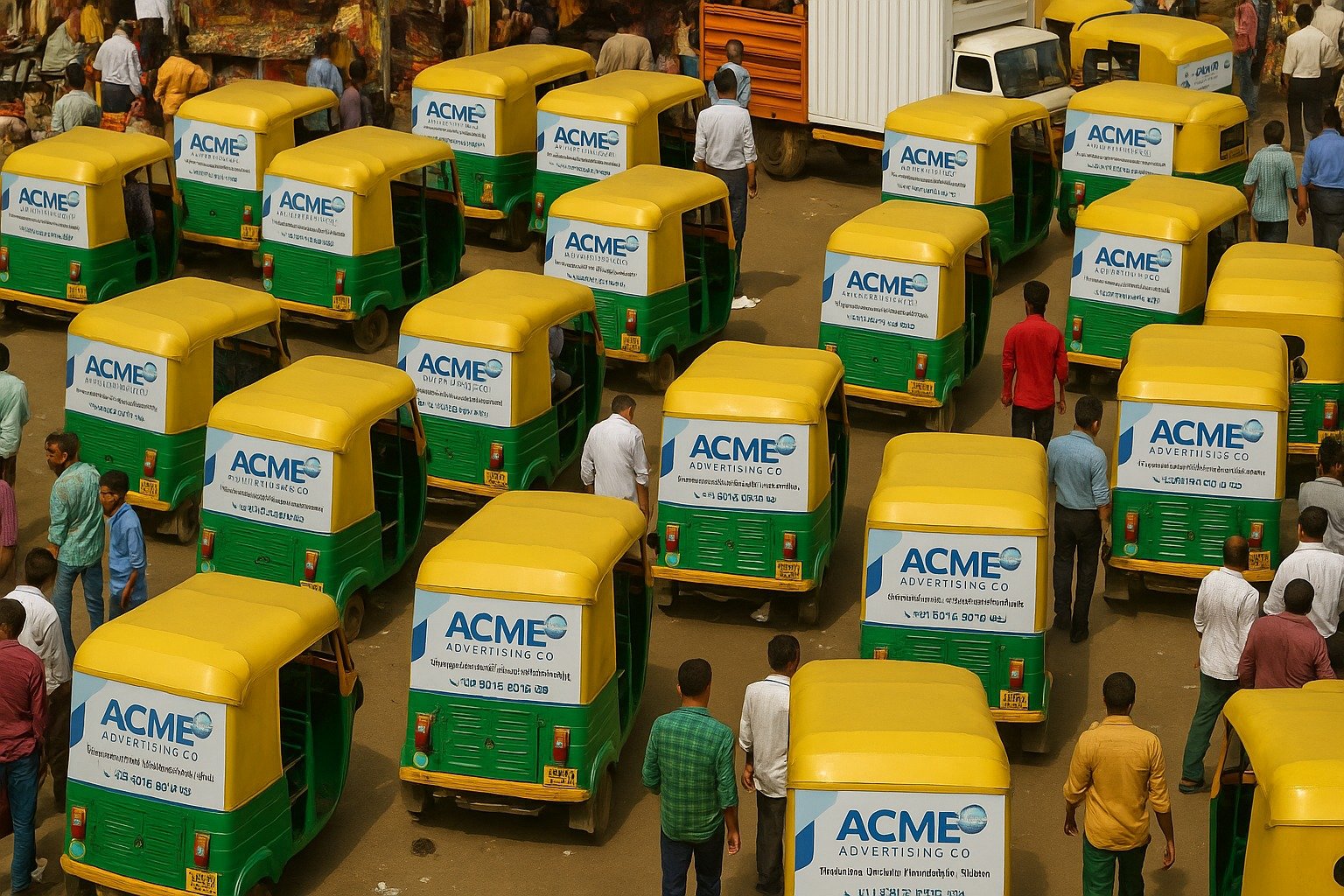As we move deeper into 2025, outdoor advertising in India is undergoing a major shift. Traditional media formats like hoardings and digital billboards are now sharing space—and budgets—with more agile, grassroots options. One medium that’s gaining rapid momentum is auto branding—and not just because it’s affordable, but because it’s strategic, scalable, and street-smart.
Below, we explore the new-age advantages of auto branding that are not just about cost or mobility, but about how it shapes brand behavior, local relevance, and growth potential in India’s diverse consumer ecosystem.
1. Brand Behavior is Local—Auto Branding Responds Accordingly
While big brands often focus on national campaigns, India is a mosaic of hyperlocal markets. From language to consumption patterns, each neighborhood has its own pulse. Auto branding fits seamlessly into this landscape by embedding your brand into the rhythms of daily life.
Auto rickshaws act as cultural touch points—they aren’t just vehicles but part of the local conversation. Placing your brand on them is like placing it inside the story of a city. This humanized form of marketing moves with the people, not just past them.
2. Shifts in Trust: Physical Visibility Wins
Consumers in 2025 are overwhelmed by digital noise and skeptical of online ads. Physical visibility has reclaimed its value. A brand seen repeatedly on autos signals stability, familiarity, and confidence. People are more likely to trust what they see every day on their commute, outside their homes, or at the market gate.
Auto branding isn’t just OOH—it’s trust-building on wheels.
3. Behavioral Momentum: Repetition Fuels Recall
Unlike static hoardings that may be ignored after a few days, branded autos reappear on new streets, at different times, from different angles. This rotating visibility supports behavioral momentum, a principle in marketing psychology where repeated exposure nudges people toward brand recognition and, eventually, action.
It’s not just about “impressions”—it’s about building memory across touchpoints that move.
4. Flexible Deployment: Campaigns That Adapt on Demand
Auto branding is one of the few OOH mediums that can be recalibrated mid-campaign. Launching a new store in South Delhi next month? Need to shift focus to Navi Mumbai during Diwali? Auto fleets can be rerouted or redesigned in a matter of days.
In 2025, where flexibility equals relevance, this adaptability is a competitive edge.
5. Bridging the Urban–Rural Gap with Mobile Messaging
India’s advertising challenge lies in bridging urban sophistication with rural aspirations. Auto branding is uniquely positioned to serve both. In cities, it moves through tech parks, markets, and transit hubs. In smaller towns and peri-urban regions, it’s often the most visible and relatable medium.
As Bharat meets India, auto branding unites both with a shared visual narrative.
6. Storytelling in Motion: Your Brand in Transit, Not in Silence
The true power of auto branding lies in how it animates your message. A beauty brand targeting college students can pair bright creative with short routes near campuses. A financial service can use bold, authoritative designs near commercial corridors.
Autos become traveling storytellers, giving your brand a moving identity—one that’s designed not just to be seen but to be felt.
7. Emergence of Vernacular Campaigns: Speak the Street Language
India’s Tier 2 and Tier 3 cities are where growth is happening—and these audiences respond to local dialects, references, and humor. Auto branding in 2025 is increasingly vernacular-first, letting you speak the language of your consumer, not just in words but in design cues, colors, and cultural symbols.
This nuanced local connect is something no digital banner can replicate.
8. Scalability with Real Human Networks
Unlike digital campaigns run by algorithms, auto branding operates through a physical network of drivers, vendors, and coordinators. This human-powered infrastructure means real relationships, better accountability, and often, organic amplification.
When drivers themselves become informal brand ambassadors, the campaign gains credibility on the ground.
9. 360-Degree Integration with Offline + Online Journeys
Auto branding doesn’t have to live in isolation. In 2025, brands are integrating QR codes, NFC tags, and SMS shortcodes into their wraps. This turns every auto into an entry point to a digital journey—leading users to offers, websites, product trials, or app downloads.
OOH is no longer just awareness—it becomes engagement in motion.
10. Future-Proofing Brand Visibility in Unpredictable Times
With rising digital ad costs, increasing data privacy concerns, and fluctuating media consumption patterns, brands need visibility channels that are stable, compliant, and rooted in the real world.
Auto branding is low-risk, high-impact, and independent of platform policies or algorithm shifts. It’s a future-proof channel that works in uncertainty—and delivers regardless of tech disruptions.
🚀 Want to Launch an Auto Branding Campaign That Actually Moves the Needle?
Work with an auto branding agency that understands your audience, your location, and your goals. Let your brand drive conversations on the streets of India CONTACT US.
Expand your network with us! Connect with us on LinkedIn

